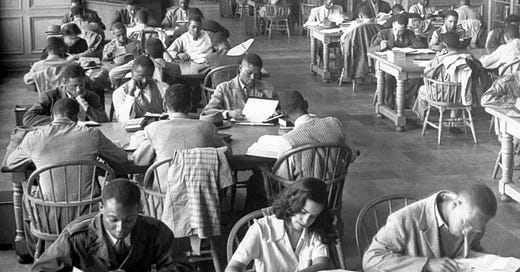Black Is Analytics
Welcome to issue #8! 🧮
It’s the final issue of our March theme, Black is Analytics! New readers, you can visit our archive to learn more about Black To School and catch up on all past issues. If you received a forwarded issue, you can subscribe for yourself right here.
Black To School is a newsletter for all people interested in learning more about the contributions of Africans and the African diaspora to global society. We’re excited to learn from these stories, draw inspiration, and be the change that we want to see in our own lives, homes, and communities.
A special thanks 🙏🏾 to the readers below who were our “Golden Griots'' (or top sharers) for last week's issue. We’re so grateful that you’re sharing #blackstories and our collective history within your networks! Please keep spreading the word.
Pamela W.
Nik R.
Sharon S.
Stacy B.
Saamra M.
Adina K.
Throughout March, we explored Black mathematical talents and how they’re put to work in the world. In this final issue, we’ll:
Get to know Black teachers, advisors, and advocates who are reimagining how math and science are taught and experienced in the classroom.
Step into the future with these creative and effective programs that prepare students for promising careers and a great life.
The STE(A)M Dream
Contributor: Atoya Burleson
Throughout this month, we’ve showcased just how early (34,000+ yrs ago) our analytic contributions to the world began. We’ve highlighted the depth and breadth of our mathematical genius. The impact of which continues to inspire the next generation and benefit us all.
As Black human computers helped land the first human on the moon, the country began to focus on science careers and education. Everything changed when America’s first Black President, Barack Obama committed, much like the bold goal that launched us into space, to restore our academic excellence in science, technology, engineering, and mathematics (STEM) around the world. Our national focus on STEM was later expanded to STEAM in order to include arts education.
“The key to meeting these challenges -- to improving our health and well-being, to harnessing clean energy, to protecting our security, and succeeding in the global economy -- will be reaffirming and strengthening America's role as the world's engine of scientific discovery and technological innovation. . . . We've launched a $4 billion Race to the Top fund, one of the largest investments in education reform in history. . . . [This is] a nationwide effort to help reach the goal this administration has set: moving to the top in science and math education in the next decade. ”
- President Barack Obama, Educate to Innovate Campaign Address (2009)
Ten years have come and gone and America’s academic rank is not yet among the global top 10 in math or science. Yet there has been significant progress in attracting billions in public-private investments. Also, colleges and universities are graduating 261,000 more (+55%) students with STEM degrees. Although there is some cause for celebration, there are still significant gaps in the share of Black STEM bachelor and graduate degree holders.
With continued growth in jobs that require computers and math as well as the 25%+ premium in income that Black STEM degree holders can earn as compared to their non-STEM degreed peers, there is no better time than now to understand what works in closing this gap.
Why HBCUs are essential to America winning in STEM?
Historically Black Colleges & Universities (HBCUs) were originally referred to as “Institutes”. The first HBCUs were established before the Civil War to teach elementary and high school education to Black Americans. Their initial curricula focused on technical training in agricultural, mechanical, and industrial trades. They didn’t offer college level studies until the 1900s. From the founding of the original 16, in the early 1800s, there are now 101 HBCUs in the United States with a total enrollment of 292,000.
HBCUs represent a small, but mighty part of our educational system. Some of the most prolific African American STEM leaders in history attended HBCUs like Howard University, Tuskegee University, West Virginia State University, and more, including Booker T. Washington, George Washington Carver, Kelly Miller, Katherine Johnson, Lonnie Johnson, Patricia Bath, Alma Levant Hayden as well as our first female Vice President, Kamala Harris.
Black students at HBCUs represent 9% of all of the Black students enrolled in universities and colleges around the world. While Black HBCU STEM graduates are 25% of all Black STEM graduates, including 46% of all Black female STEM graduates and 30% of all STEM PhDs. Ten of the top 11 universities that produce Black PhDs are HBCUs. Their STEM degree rates are 2x higher than all non HBCUs combined.
After countless national and local studies, there are three essential elements to increasing both the interest in and performance of Black students in STEM, which are all focused on creating a sense of “belonging”: (1) Racial and gender representation, (2) Culturally responsive lessons, and (3) Peer networks within their discipline. HBCUs are striking all of the right notes. These African American institutions are consistently besting Harvard University, Yale University, and other more well-endowed universities in producing Black STEM graduates.
Spelman College, Xavier University, and Howard University STEM programs are award-winning models that bring to life the feeling of “belonging” through everything from teacher and peer mentoring to career counseling and internships. HBCU math and science programs illustrate beyond a shadow of a doubt that representation matters in unlocking our analytical talents and achieving our highest potential.

How do we scale what works?
As a result of a renewed national commitment and their sustained success in educating STEM professionals, the world is taking notice of HBCUs. Recently, Howard University received the largest donation in its 154-year history. In late 2020, the National Science Foundation commissioned a group of HBCUs to conduct the most comprehensive study ever on STEM student enrollment and retention. Their findings will be shared with all colleges and universities to improve national STEM performance.
Beyond the campus, others are applying lessons learned on their own campuses. Washington State passed an “academic acceleration” law; the National Association of Black Engineers (NSBE) is expanding its member model; and the organization 100Kin10 has prepared 93,000 new STEM educators. As the competition for jobs of the future grows, we have a clear opportunity to learn from institutions that have over two centuries of success in training some of the brightest minds. STEM analytics is in our DNA and ready for full integration into classrooms.
🛠️ The Black To School Toolkit
Now What? Dig Deeper with Friends, Family, and Others.
Need clarity on what STEM really is? Learn more by watching this illustrated 3-minute video “STEM Integration in K-12 Education”. Click here to see real time data on STEM performance for each state, grade level, and race.
Curious about how “belonging” makes a difference in educational achievement? Watch “Why Choose an HBCU?”. A 2-minute video on the magic of HBCUs for talented Black students. Want more? Check out “Tell Them We’re Rising!”. A 90-minute video on why and how Black Colleges and Universities were established.
Ready to share STEM education with your kids? This is an awesome list of STEM books that beautifully represents our next generation (ages: 4-12). Got older kids? Give them an extra hour of screen time to play these fun STEM games (grades: middle to high school)
Getting ready for the college application shuffle? Participate with your middle or high schooler in one of these upcoming virtual HBCU tours or plan an on-campus visit. Looking for a leg up? Register your young scholar in one of these STEM summer programs at top universities across the country.
Curious how to shake things up in your kid’s classroom? Share these STEM resources with their teacher. Sutori is a really cool and effective lesson planning and presentation tool created by a network of 1.5 million educators.
Are you an employer looking to hire more STEM grads? Click here to read what some African Americans with STEM jobs say about the importance of diversity in the workplace. Looking to remove bias from your hiring process? Partner with the organization, Karat, to improve your interviews. They have conducted over 80,000 interviews with brilliant Black minds.
⌛ The Black To School Timeline
STEM Analytics is in Our DNA and Ready for Full Integration into Classrooms.
We started by getting a glimpse of the Stone Age (Over 43,000 Years Ago) The Thing: Lebombo bone, the first calculator in the world, created by African women, which laid the groundwork for advanced math used around the world.
Then learn what happened in the 17th & 18th Century (About 300 to 400 Years Ago) The People: Enslaved mathematicians, including Thomas Fuller and Benjamin Banneker whose genius and contributions defied and threatened the institution of slavery.
We built on that knowledge by visiting NASA in the 1950s (70 Years Ago) The Place: West Area Computers, the Black female mathematicians whose calculations put a man on the moon.
Finally, we explored what is new and true in STE(A)M today (Here and Now) The Practices: These experiments and promising approaches have students, parents, educators, artists, and futurists excited about reinventing the way we learn and experience math.
About This Week’s Contributor
Atoya Burleson
Atoya Burleson is an accomplished athlete, educator, and business woman with both a psychology degree as well as a masters degree in education.
Atoya has mentored and coached high school student athletes and worked with the National Collegiate Athletic Association (NCAA) compliance program to ensure student athletes are set up for success. She also gives back by supporting those who are looking to further their careers in education, professional sports, and beyond. Follow Atoya at atoyaburleson.com where she shares education, lifestyle, family, and more.
About Black To School
Black To School is a collaborative volunteer effort focused on sharing Black history, collecting helpful resources, and creating a safe space for discussion. Learn more about us here and feel free to join our Slack community to keep the conversation going. People of all backgrounds are welcome!
If you’re passionate about this type of work and want to help out, please let us know! The best way to get in touch is by emailing info@blcktoschool.com with “volunteer” as the subject, or by joining our Slack community and sharing that you’d like to be involved.






